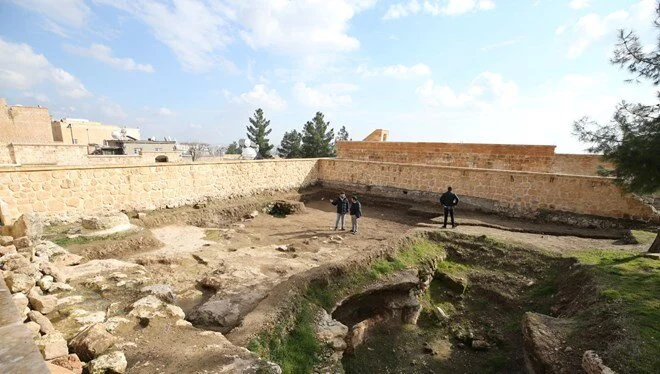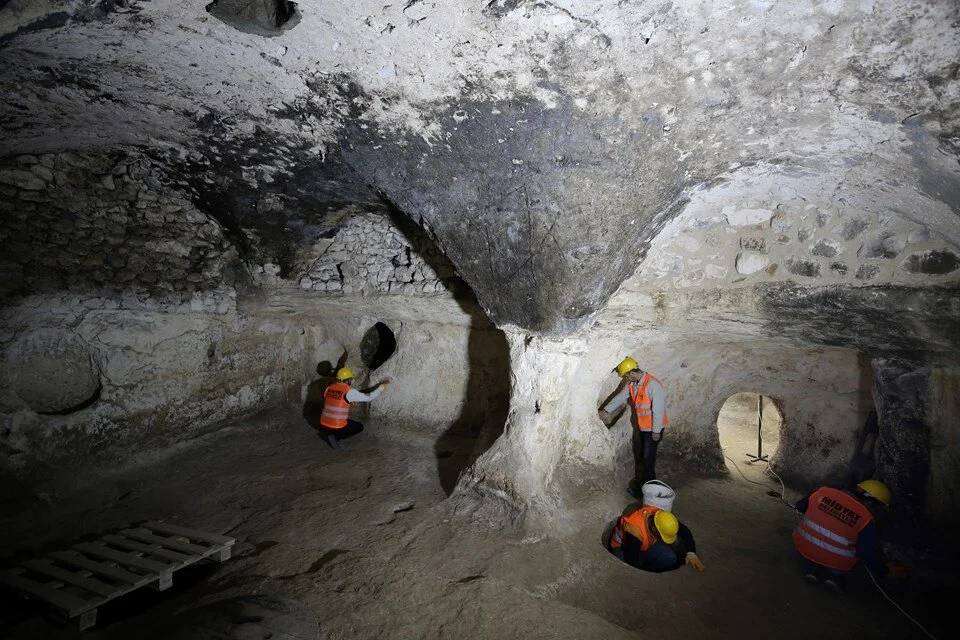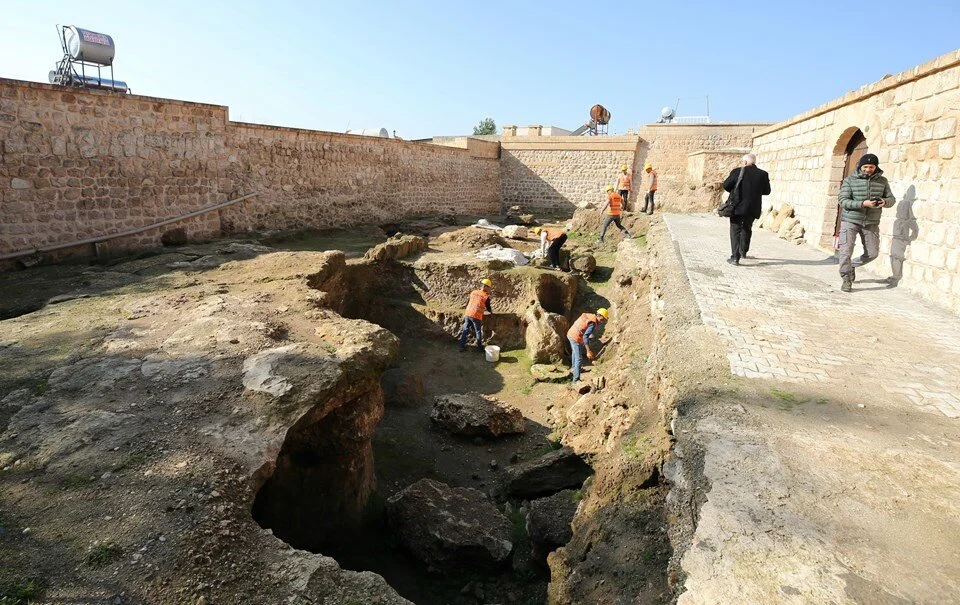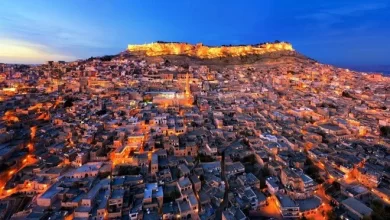5 Thousand Years Old Underground City In Mardin
In Mardin's Midyat district, 2 phases of the 5,000-year-old underground city, which includes a place of worship, silos, water wells, shelter, winery, workshops, cisterns and burial grounds, and passages with passageways, will be opened to visitors this year.

In Mardin’s Midyat district, the 4th season of the excavation work carried out to reveal the underground city started after it was determined that the cave, which was found and cleaned within the scope of the work initiated 4 years ago in historical streets and houses, was not the only one and that there was a transition to different places through the passages.

With the cooperation of the Ministry of Culture and Tourism General Directorate of Cultural Assets and Museums, Mardin Museum and Midyat Municipality, excavations have been carried out meticulously at 2 points in Ulu Cami Neighborhood in the Estel region for 4 years. In the 1st and 2nd stage cleaning and excavation works of the underground city, which was found to spread over a very large area and was determined to be approximately 5 thousand years old according to the findings, an area of 8 thousand 223 square meters and a tunnel of approximately 120 meters connected to these areas were uncovered.

In the underground city, where there are places of worship, silos, water wells, shelter, wort house, workshops, cisterns and burial sites, tunnels and passages, oil lamps, spindle whorls, a hand mill, stone and glass beads, stone artifacts, bronze coins and jewelry, terracotta tools, as well as bones belonging to humans and different animals dating back to different periods were found.

The restoration and Visitor Reception Center projects prepared for the 1st and 2nd stages, where the works have come to the point of completion, have been approved by the Mardin Regional Board for the Protection of Cultural Assets. The two stages of the underground city, which is aimed to become the most popular destination center of Mesopotamia, are expected to be opened to tourism this year.
“We Will Tender The Visitor Welcome Center This Month”
Midyat Mayor Veysi Şahin told AA correspondent that Turks, Kurds, Arabs, Muslims, Assyrians and Yazidis have been living together for centuries in Midyat, which has a multicultural structure. Noting that the excavations they started to reveal the underground city in the historical district are continuing, Şahin reported that this year, work will be carried out in new stages determined in coordination with the General Directorate of Cultural Assets and Museums.
Noting that the restoration and Visitor Welcome Center projects were approved for the first two stages, Şahin said that they plan to complete the projects in a very short time and open the 2 stages to tourism:
“We plan to open the 1st and 2nd stages to tourism this year. This month we will make the tender for the Visitor Welcome Center. In 6-7 months, the underground city will be opened for tourism. When we open the entire underground city in Midyat to tourism, it will be one of the largest underground cities in the world. Towards the end of the year, we will open the 1st and 2nd stages to the service of our guests. Tourists are curious and apply to us even though it is not open for service. For security reasons, we cannot accept visitors at the moment.”
Stating that they host an average of 1 million tourists a year and that they expect 1.5 million tourists this year, Şahin stated that the potential of the district in terms of tourism is very high.

Explaining that there are destination points that they cannot open to tourism, Şahin added that their goal is to approach 2 million tourists.
“A 5 Thousand Year Old City, Work Will Continue In Stages”
Excavation head Gani Tarkan said that they started the 4th season of excavations that started in 2020. Noting that the work continues in the southern parts of the hillside settlement, Tarkan continued as follows:
“This season, a workshop and a cave area were identified. We see that the cave was expanded by taking stones from the cave. According to the stones taken, a house dating back to the early 20th century was built just above the cave. We are currently in the upper layer in the excavation area. There is fill soil that has not been removed. We anticipate that there will be places under the filling soil that will provide passage to other places.”
Stating that the underground city consists of an area of approximately 40 hectares and that 6-7 percent of it has been uncovered so far, Tarkan emphasized that the excavations will continue for years. Pointing out that they have reached many structures and finds so far, Tarkan continued his speech as follows:
“Settlement began in the 3rd millennium BC in the underground city of Matiate. It starts in the Bronze Age and continues uninterruptedly. There are also many finds from the Roman period. Intensive ceramic finds such as coins, oil lamps, water flasks, glass bracelets and daily use items were found. In addition, we found a large number of medieval ceramics. We also found ceramics dating back to the Bronze Age, but these are in the local area. However, we encounter finds from the Middle Ages and Roman period throughout the excavation area. It is a 5 thousand year old city, and excavations will continue in stages. Our goal is to reveal the entire underground city and open it to tourists in stages.”
“Matiate Is The Pioneer Of Other Underground Cities”
Mervan Yavuz, art historian and in charge of the Midyat Municipality’s Conservation, Implementation and Inspection Offices, said that they are meticulously carrying out the work with archaeologists, art historians and 10 workers.
Noting that the 1st and 2nd stages of the works have reached the completion stage, Yavuz said that they have reached important finds in the area they have uncovered so far, and according to the findings, they have seen that the history of the underground city dates back to the Bronze Age. Noting that there are underground cities in many parts of the world and that the similar underground city in the district is in the Cappadocia region, Yavuz said:
“The importance of the Matiate underground city stems from its location in the middle of the fertile crescent. We see that the Matiate underground city is the pioneer of other underground cities because the spread took place from here. The difference from other underground cities is that the civil architecture is located above the underground city. This shows us how the underground city has survived to the present day. We can observe the transition from underground city to urban life in stages. At the same time, some underground cities, such as Cappadocia, descend vertically. This one is horizontal in the form of a terrace






